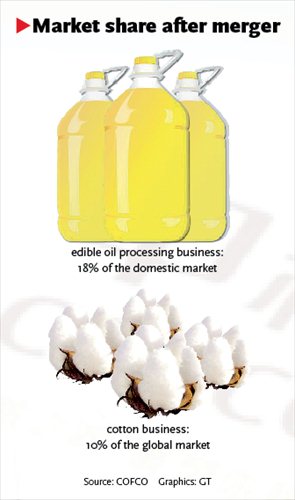HOME >> BUSINESS
COFCO cuts operations after merger with Chinatex
By Chen Qingqing Source:Global Times Published: 2016/7/18 22:03:00
Challenges ahead for State-owned entity as it pursues reforms

Photo: CFP

Graphics: GT
After taking control of competitor Chinatex Corp, the giant grain and oil processor and trader China National Cereals, Oils and Foodstuffs Corp (COFCO) announced on Monday it will close six departments at its headquarters and establish professional operating platforms to manage some of its businesses.
The State-owned Assets Supervision and Administration Commission (SASAC) approved the merger of the two State-owned enterprises (SOEs) on Friday.
COFCO said the combination will help increase its market share in the edible oil processing sector to 18 percent, which will make it No.1 nationwide, according to an e-mail COFCO sent to the Global Times on Monday.
The company's cotton business will further develop and eventually hold 10 percent of the global market for the crop, COFCO noted in the e-mail.
Chinatex will become a subsidiary of COFCO, according to an announcement posted on the website of the SASAC on Friday.
Combining two former competitors is in line with China's SOE reform guidelines, which encourage the creation of giant, highly competitive entities in various industries, Feng Liguo, an expert at the Beijing-based China Enterprise Confederation, told the Global Times on Monday.
"However, COFCO has little experience in operating the textile and cotton-spinning businesses of Chinatex, which is likely to be challenging after the merger," Feng said.
The companies have similarities, however, in grain and edible oil processing, as well as trade and logistics, and the tie-up will improve Chinatex's competitiveness as well as its probability, COFCO Chairman Zhao Boya told a meeting held Monday morning.
Further streamlining operations and transforming the company into a "pilot investment firm" are the next steps that COFCO will take in restructuring, the company noted in the e-mail.
The number of staff at its headquarters will be downsized from 610 to less than 240, according to the e-mail. However, COFCO did not specify whether those employees will be transferred to other positions or be laid off.
COFCO had planned to reduce losses by more than 50 percent in the next three years and had identified 65 subsidiaries for improvement and 91 subsidiaries for intensive management, according to a statement posted on the website of the SASAC on June 13. Also, the company would restructure 102 subsidiaries through mergers and acquisitions (M&As), the post showed.
M&As are not enough, though and companies shouldn't see them as crucial to SOE reforms. Building a modern corporate structure including an effective board of directors and an appropriate staff recruitment system has to be further emphasized, noted Liang Jun, a research fellow with the Guangdong Academy of Social Sciences.
"We are paying too much attention to downsizing the State sector now," Liang said, noting that some media reports said the motivation behind the merger is that SASAC intends to reduce the number of SOEs to less than 100.
The shrinkage of the sector has been wrongly seen as part of the SOE reforms.
COFCO noted in the e-mail that the company will assign responsibility for asset allocation, production, research and development, employee evaluations, payroll and recruitment to 18 professional operating platforms.
By 2020, the company will develop two or three platforms that generate 100 billion yuan ($14.91 billion) in annual revenue and four or five that generate 50 billion yuan, the e-mail said.
COFCO will hire more professional managers and establish an incentive-based compensation system, it said.
However, the company didn't give details about how those platforms will operate or what the hiring process will be, Liang noted.
"It's still vague in terms of how COFCO will be transformed into an investment firm or a modern company," he said.
As the next step in SOE reforms, COFCO should also separate its two major sectors. One is for edible oil and grain products traded in the market, the other is foodstuffs production and management for State reserves, Feng said.
Posted in: Companies